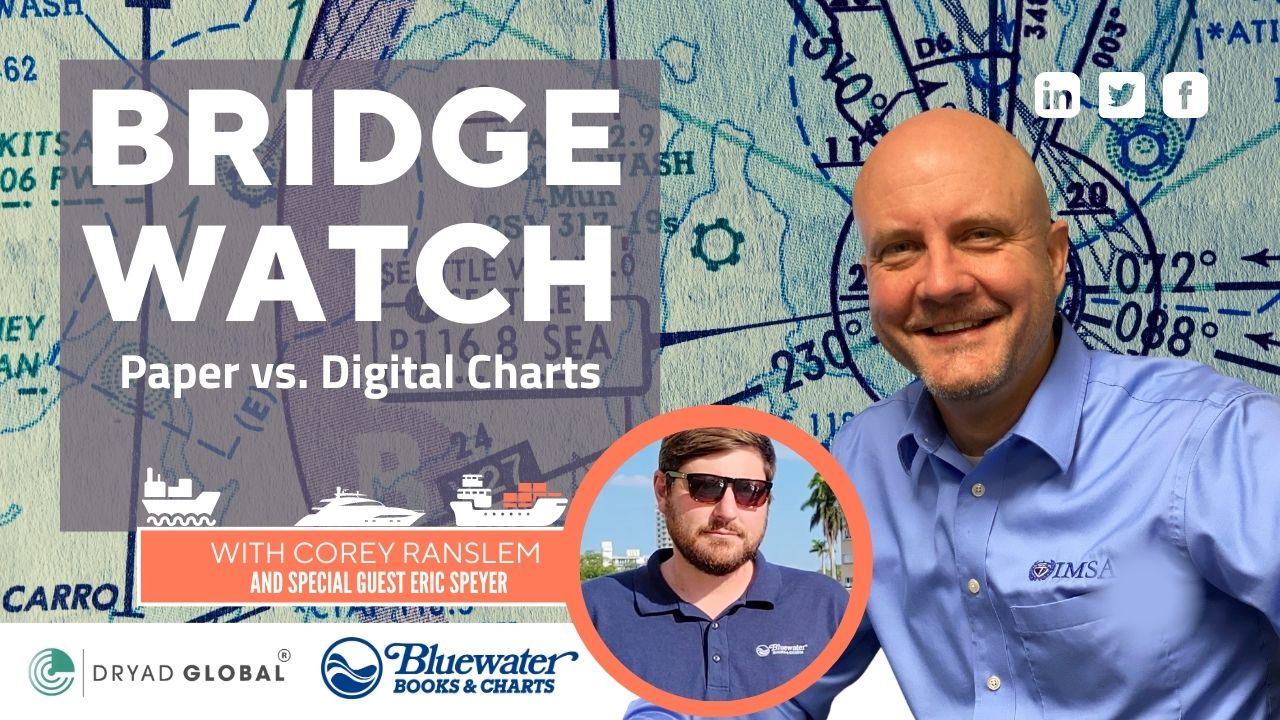
In this episode of Bridge Watch, Dryad Global's CEO Corey Ranslem talks digital vs paper charts and what the future looks like for global shipping.
His guest interview this week is Erik Speyer from Bluewater Books & Charts. Is the complete sunsetting of paper charts on the horizon? The UKHO says the transition isn't likely to happen until at least 2030. Why? Because as yet there isn't a viable alternative to paper charts for many stakeholders. The UKHO is set to work closely with the IMO to develop a framework to move away from paper charts and ensure that regulatory compliance is in place.
Find out more about what the future holds for papercharts: https://www.bluewaterweb.com/
Find out more about the digitisation of shipping: www.dryadglobal.com
There is no definitive timeline for when paper maritime charts will stop being produced, as this will ultimately depend on a range of factors, including the demand for physical charts from mariners, advancements in digital navigation technology, and the policies of individual hydrographic offices around the world. However, it is worth noting that the use of digital navigation tools has been increasing in recent years, and many mariners now rely on electronic charting systems for navigation.
This trend is likely to continue, and it is possible that in the future, paper charts may become less commonly used. That being said, many mariners still prefer to use paper charts as a backup to electronic systems, or for planning purposes, and there are also some regions where electronic charts may not be readily available or may not be deemed reliable enough for navigation. Additionally, there are certain types of specialized charts, such as large-scale harbor charts or historical charts, that may only be available in paper form. Therefore, it is likely that paper maritime charts will continue to be produced for the foreseeable future, although their use may become less widespread over time.
The UK Hydrographic Office (UKHO), which is responsible for providing nautical charts and publications to mariners in the UK, recognizes that there is still a demand for paper charts among some users. In recent years, the UKHO has made efforts to balance the production of paper charts with the development of digital products, to ensure that mariners have access to the information they need in the format that best suits their needs. In its publication policy, the UKHO states that it will continue to produce paper charts for as long as there is demand for them, but also recognizes the benefits of digital products, such as the ability to update information more quickly and the reduced storage requirements compared to paper charts. The UKHO encourages mariners to use a combination of paper and digital products to ensure they have the most up-to-date information available.
Additionally, the UKHO has developed a range of digital products, such as Admiralty e-Nautical Publications and Admiralty Digital List of Lights, which are designed to complement its paper products and provide mariners with a range of options for accessing the information they need. Overall, the UKHO's approach to paper charts is to offer them as a choice alongside digital options, rather than to phase them out entirely. The International Maritime Organization (IMO), the United Nations agency responsible for the safety and security of shipping and the prevention of marine pollution by ships, recognizes the value of both paper and digital charts in navigation. In its guidelines on the use of electronic chart display and information systems (ECDIS), the IMO acknowledges that the use of digital navigation systems can enhance safety and efficiency, but also notes that paper charts are still an important tool for navigation and should be carried as a backup.
The IMO recognizes that the transition to digital navigation systems is an ongoing process, and that there may be a period of coexistence between paper and digital charts. Therefore, the IMO encourages member states to develop policies and procedures for the use of both paper and digital charts, and to ensure that mariners are adequately trained in the use of both types of charts.
Overall, the IMO's stance is that both paper and digital charts have their advantages and disadvantages, and that the most effective approach is to use a combination of both to ensure the safe and efficient navigation of vessels.
Related Posts
Weekly Maritime Security Threat Advisory 16th Jan..
Access the latest Maritime Security Threat Advisory for the week commencing 15th Jan 2024.
Weekly Maritime Security Threat Advisory 5th Feb..
Access the latest Maritime Security Threat Advisory for the week commencing 5th Feb 2024.
Weekly Maritime Security Threat Advisory 8th Jan..
Access the latest Maritime Security Threat Advisory for the week commencing 8th Jan 2024.




